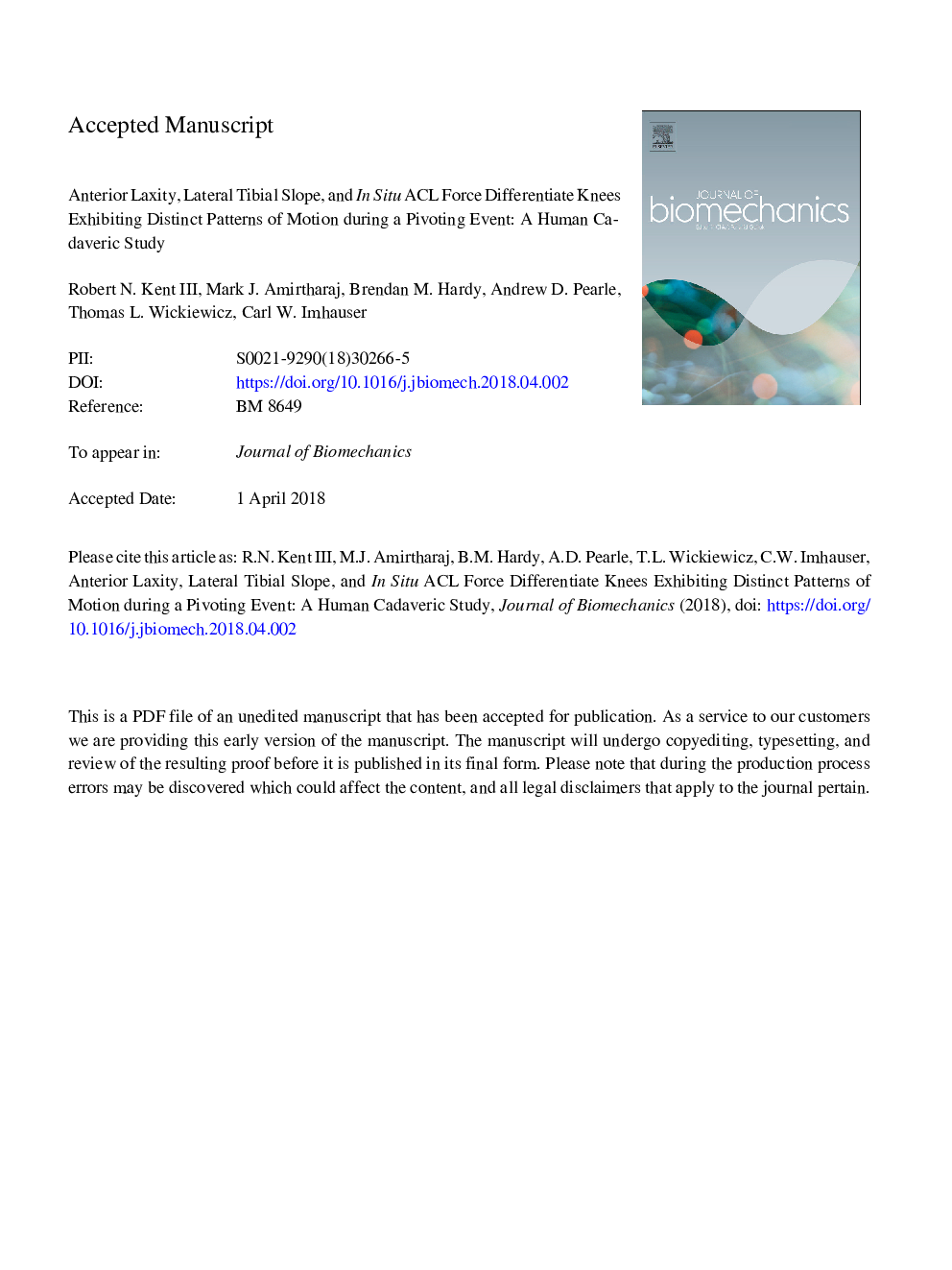| کد مقاله | کد نشریه | سال انتشار | مقاله انگلیسی | نسخه تمام متن |
|---|---|---|---|---|
| 7235941 | 1471090 | 2018 | 26 صفحه PDF | دانلود رایگان |
عنوان انگلیسی مقاله ISI
Anterior laxity, lateral tibial slope, and in situ ACL force differentiate knees exhibiting distinct patterns of motion during a pivoting event: A human cadaveric study
دانلود مقاله + سفارش ترجمه
دانلود مقاله ISI انگلیسی
رایگان برای ایرانیان
کلمات کلیدی
موضوعات مرتبط
مهندسی و علوم پایه
سایر رشته های مهندسی
مهندسی پزشکی
پیش نمایش صفحه اول مقاله

چکیده انگلیسی
Knee instability following anterior cruciate ligament (ACL) rupture compromises function and increases risk of injury to the cartilage and menisci. To understand the biomechanical function of the ACL, previous studies have primarily reported the net change in tibial position in response to multiplanar torques, which generate knee instability. In contrast, we retrospectively analyzed a cohort of 13 consecutively tested cadaveric knees and found distinct motion patterns, defined as the motion of the tibia as it translates and rotates from its unloaded, initial position to its loaded, final position. Specifically, ACL-sectioned knees either subluxated anteriorly under valgus torque (VL-subluxating) (5 knees) or under a combination of valgus and internal rotational torques (VL/IR-subluxating) (8 knees), which were applied at 15 and 30° flexion using a robotic manipulator. The purpose of this study was to identify differences between these knees that could be driving the two distinct motion patterns. Therefore, we asked whether parameters of bony geometry and tibiofemoral laxity (known risk factors of non-contact ACL injury) as well as in situ ACL force, when it was intact, differentiate knees in these two groups. VL-subluxating knees exhibited greater sagittal slope of the lateral tibia by 3.6â¯Â±â¯2.4° (pâ¯=â¯0.003); less change in anterior laxity after ACL-sectioning during a simulated Lachman test by 3.2â¯Â±â¯3.2â¯mm (pâ¯=â¯0.006); and, at the peak applied valgus torque (no internal rotation torque), higher posteriorly directed, in situ ACL force by 13.4â¯Â±â¯11.3â¯N and 12.0â¯Â±â¯11.6â¯N at 15° and 30° of flexion, respectively (both pâ¯â¤â¯0.03). These results may suggest that subgroups of knees depend more on their ACL to control lateral tibial subluxation in response to uniplanar valgus and multiplanar valgus and internal rotation torques as mediated by anterior laxity and bony morphology.
ناشر
Database: Elsevier - ScienceDirect (ساینس دایرکت)
Journal: Journal of Biomechanics - Volume 74, 6 June 2018, Pages 9-15
Journal: Journal of Biomechanics - Volume 74, 6 June 2018, Pages 9-15
نویسندگان
Robert N. III, Mark J. Amirtharaj, Brendan M. Hardy, Andrew D. Pearle, Thomas L. Wickiewicz, Carl W. Imhauser,